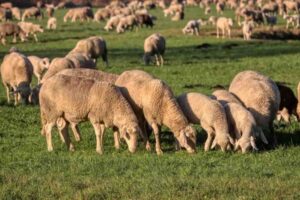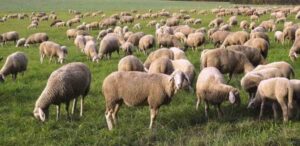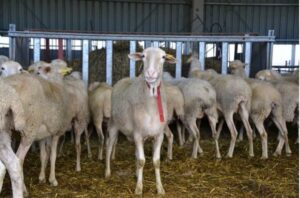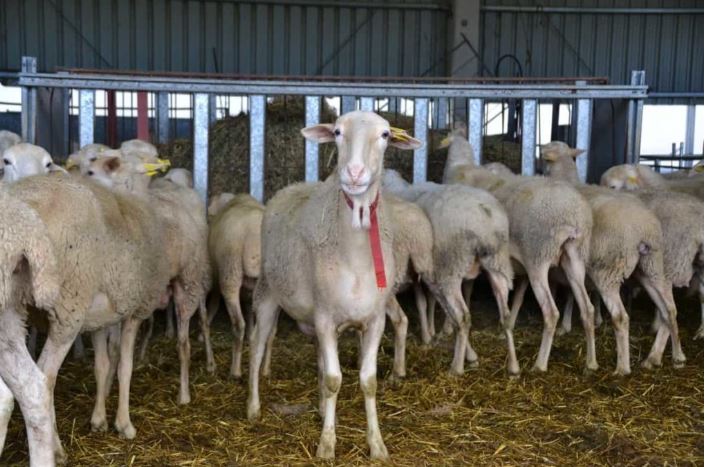Success Story: The technique of raising domestic sheep is referred to as sheep farming or sheep husbandry. It falls within the umbrella of animal husbandry. Sheep are raised primarily for their milk (sheep’s milk), fleece, and meat (lamb and mutton). Additionally, sheep can be raised in a variety of temperate conditions, including deserts near the equator and other hot and humid regions.

On their properties, farmers construct fences, houses, shearing sheds, and other water, feed, transportation, and pest control infrastructure. Most farms allow sheep to graze in pastures while being watched over by a shepherd or sheepdog. Learn how one farmer’s sheep farming generated a 5 lakh profit.
Sheep farming, also known as sheep husbandry or sheep rearing, has several advantages. Here are some of the key benefits of sheep farming:
- Profitability: Sheep farming can be a profitable venture, especially when managed efficiently. Sheep are relatively low-cost animals to raise, and they can produce various products such as meat, milk, wool, and lanolin, which can be sold for income generation.
- Multiple products: Sheep provide multiple valuable products. The meat from sheep, commonly known as lamb or mutton, is a popular and nutritious source of protein. Sheep milk can be used to produce cheese, yogurt, and other dairy products. Additionally, sheep wool is highly versatile and can be used in the textile industry to create clothing, carpets, blankets, and other items.
- Sustainable land use: Sheep farming can be an effective means of utilizing land that may be unsuitable for other agricultural purposes. Sheep are known to graze on a wide range of vegetation, including grasses, herbs, and shrubs, which allows farmers to utilize pastureland that may not be suitable for crops.
- Fertilization and weed control: Sheep can contribute to soil fertility through their manure. Sheep droppings act as a natural fertilizer, enriching the soil with nutrients. Additionally, their grazing habits can help control weed growth, reducing the need for herbicides.
- Environmental benefits: Compared to some other forms of livestock farming, sheep farming generally has a lower environmental impact. Sheep have a relatively small carbon footprint and produce less greenhouse gas emissions compared to larger livestock such as cattle. Moreover, their grazing behavior can help maintain grassland ecosystems and prevent the spread of invasive plant species.
- Low infrastructure requirements: Sheep farming can be practiced on a smaller scale with fewer infrastructure requirements compared to other livestock farming operations. They do not require extensive housing or specialized facilities, making it more accessible to smaller farmers or those with limited resources.
- Diversification: Sheep farming can be an effective way to diversify an existing farm operation. Integrating sheep into a mixed farming system can provide additional income streams and reduce reliance on a single agricultural enterprise.
- Cultural and traditional value: Sheep farming holds cultural and traditional value in many regions worldwide. It has played a significant role in the economies and traditions of various countries and communities, contributing to cultural heritage and local identities.
While sheep farming has its advantages, it is important to note that it also requires appropriate management practices, including animal welfare considerations, disease control, and proper land and pasture management.

How this farmer made 5 lakh profit from sheep farming
The success story of Mr. Sai Eshwar Rao
The secrets to success in any industry are tenacity, tenacity, and commitment. A degree-holding young man who began breeding 50 sheep two years ago now feeds 150 sheep and makes a net profit of 50,000 each month. The revenue has been promising despite some herd expansion when raising sheep at a labor-intensive level and selling progeny every three months. Inbreeding with a lower risk.
Munga Young farmer Sai Eshwara Rao hails from Jagannadhapuram village in Khammam district’s Chintakani zone. They raised sheep as their caste occupation because they were Yadavas. His father used to raise a lot of sheep outside in the past. Breeding danger increased as the availability of feed decreased. Sai Eshwara Rao wanted to get a job, but his pay was meager, so he began sheep farming with his father’s support.
In contrast to extensive grazing, the sheep are given four and a half hours of grazing per day within a 4-kilometer radius of the hamlet and full-time grazing in sheds. The animals on his farm now appear to be in motion. The farmer raises Super Napier, Hedge Lucerne, and Stylo Scabra fodder on 2 acres. Grass is chopped using a 5 horsepower chaff cutter.
There are 150 sheep on the farm right now, and only the young are sold; they raise their young to the age of three months. The young farmer claims that this generates a monthly revenue of at least Rs 50,000. We shall read about the experiences of this young farmer in this article, who is growing in a semi-concentrated manner and achieving decent results at a reasonable price.
Selection of breed
All of Mr. Eshwar’s purchased sheep are Nellore-bred. In this breed, male sheep can grow to weigh 50 to 60 kg while female sheep can gain 35 to 40 kg in 18 months. He especially purchased sheep from the Nellore jodipi, Nellore brown, and Nellore palla sub-breeds of this Nellore breed.
Additionally, he purchased a few Macharla breeds in order to assess their growth and contrast them with the Nellore kind. He can entirely switch to the Macharla breed if they produce superior results. They have dark patches over their white skin, making this particular Macharla breed easy to identify.
Shed construction of Mr. Sai Eshwar’s farm
Mr. Eshwar raised his sheep on property that cost him 15 cents. He then constructed a shed there that was 60 feet long and 40 feet wide. Since red dirt can absorb the liquid excrement of his sheep as well as other organic waste, he employed it as a layer on the ground for his sheep farm. This dirt can also make cleaning the shed simple. In order to protect his sheep from the summer heat, Mr. Eswar also erected fans. This shed also has mosquito netting installed.
His farm has a shed that can hold 100 sheep, and the extra sheep can use the open space outside the shelter. Since he used inexpensive materials to build the shed, he was able to do so for a relatively low cost. To prevent sheep from jumping or escaping, fencing surrounds the 15 cents of land. The sheep are protected from vermin by this fence as well.
Feed requirements of Mr. Eshwar’s sheep
On two acres of his property, Mr. Eshwar has been growing natural fodder for his sheep. This 2 acres of land is right next to his sheep farm, which eliminates the need for transportation. By using these natural feed sources properly, they are able to feed his sheep at the right moment, which promotes their growth. When he first started raising sheep, Mr. Eshwar used to grow natural feed over a square foot that could only feed 30 to 35 sheep.
But now that he uses Super Napier cattle feed, which increases the amount of feed on a given 1 acre while still being able to feed almost 70 to 80 sheep, he has overcome this issue. Super Napier grass has the ability to produce 250 tons per acre in a single year and can grow up to 18 feet tall. Protein level in Super Napier cattle feed ranges from 16 to 18 percent, which is highly beneficial for sheep’s healthy growth. Every 40 days, this grass can be gathered, and sheep can be fed on it.
Additionally, he began growing Hedge Lucerne for cattle feed on a half-acre. The cattle adore eating hedge lucerne cattle feed, and they do it with great interest. This grass has a very advantageous ability to give continuously for 5 to 6 years. According to Mr. Eshwar, this grass contains 18 to 20 percent protein. This grass can also be harvested every 40 days, much like Super Napier.
In another half acre, he is growing Stylo Scabra fodder as well. Each day, he feeds his sheep a blend of these three grass varieties. He prepares a mixture with the right ratios of Stylo Scabra, Hedge Lucerne, and Super Napier and feeds it to his sheep every day so they can grow up healthy. Every year, Mr. Eshwar spends close to one lakh rupees on his sheep farm, the most of which goes toward feed and irrigation expenses.

To feed the sheep, Mr. Eshwar utilizes a 5 hp blower model chaff cutter to cut the grass into small bits. In order to sustain this chaff cutter, he built a motor that uses three phases of current. Two tonnes of grass may be chopped per hour, and each inch can be divided into three pieces. He paid 50,000 rupees for this chaff cutter and said that it makes feeding much easier for him.
It is straightforward for him to acquire the right proportions since he first shreds Super Napier grass in a specific quantity before shredding the other two species. The sheep are fed grain in the morning, which makes them hungry and causes them to drink more water. He feeds his sheep between 50 and 100 grams of grain every day, depending on their size and age.
Rearing of Mr. Eshwar’s sheep
In accordance with a semi-intensive rearing approach, Mr. Eshwar simultaneously raises sheep outside and inside sheds. Every morning at 11 a.m., he releases his sheep into farms and the outdoors. He stated that the amount of time the sheep spend outside the shed will determine their optimum development and growth. The stress-free environment that these sheep are raised in on a daily basis is really good for their wellbeing. For sheep, this may also contribute to rapid muscle growth.
When the sheep are let out into the open, the workers clean the shed and take care of other tasks like filling water containers. At 4 pm, the sheep come to the shed once more, and the feed is then delivered to the sheep. This feed is a blend of Super Napier, Hedge Lucerne, and Stylo Scabra, as was previously described. Each sheep requires about 3 kg of feed per day, of which 2 kg is Super Napier and the other kilogram is a combination of Hedge Lucerne and Stylo Scabra.
According to Mr. Eshwar, breeding requires one male sheep for every 25 female sheep. One male sheep may quickly impregnate 25 female sheep, which will help us grow our sheep farm. According to Mr. Eshwar, he switches out these male sheep every two years to correct any genetic flaws. This may aid in the sheep farm’s rapid expansion as well. The choice of a male sheep is crucial.
Since the offspring of these sheep develop the same traits, you must select a male sheep that is strong and healthy. Always choose a male sheep from a different farm, since this might promote healthy and active reproduction. Some sheep can only have one child, but many can have two. Triplets are possible but extremely uncommon.

When sheep are 12 months old, they are considered mature. In just two years, these can reproduce three times. Sheep can become pregnant for a total of five months; one month after giving birth, they can become pregnant again.
Vaccinations for Mr. Eshwar’s sheep
Some of the frequent diseases that can be encountered in sheep include bluetongue, foot and mouth, and PPR. According to Mr. Eshwar, immunizations are preferable to treatment because treating these illnesses is more expensive and also detrimental to the health of sheep. Blue Tongue disease vaccinations should be administered in August, PPR vaccinations in January, and E.T vaccinations in May.
The sheep must receive these shots in order to protect them from illnesses. Since pregnant sheep frequently lose a significant quantity of calcium while giving birth, animals are given calcium vaccines to prevent pregnancy. Sheep with illnesses are frequently not sold. If necessary, you should also speak with a veterinarian about the appropriate sheep medication.
Marketing and profits of Mr. Eshwar’s sheep farm

At the age of three months, Mr. Eshwar sells his male sheep calves for 7,000–8,000 rupees. When the female sheep get old, he also sells between 10 to 15 of them each year. He invests over Rs. 1,000,000 on the care of 150 sheep, and the income returns range from Rs. 6,000,000 to 7,00,000,000.
As a result, he makes a profit of roughly 5,00,000 to 6,00,000 rupees a year. Mr. Sai Eswar Rao, who currently owns a sheep farm, encourages young people who are struggling with unemployment to start similar animal rearing businesses because they have a high potential for profitability.
Read More: Zero Grazing Sheep Farming: How to Start, Business Plan for Beginners
Read More: How to Start Sheep Farming From Scratch: A Detailed Guide for Beginners


